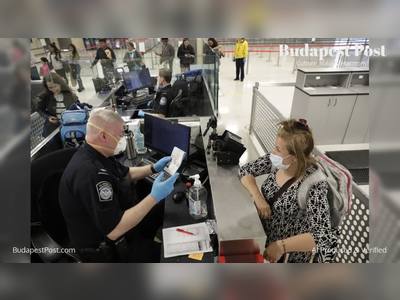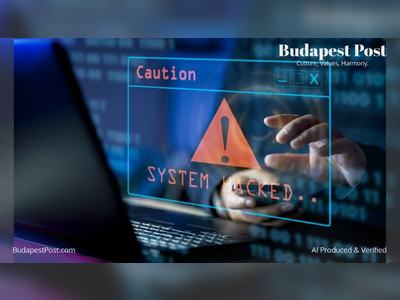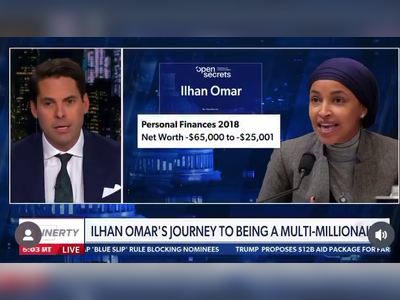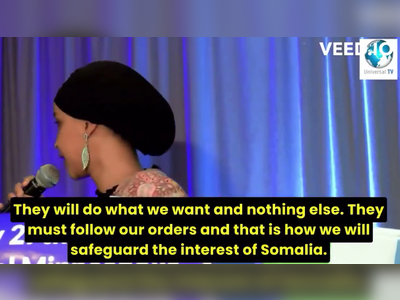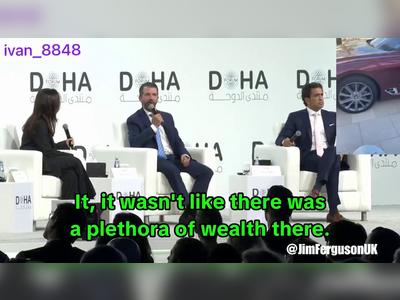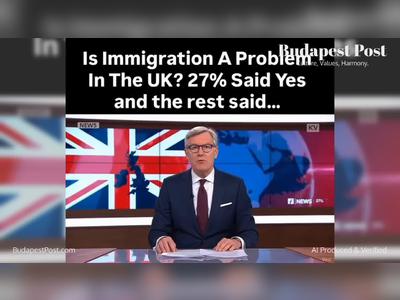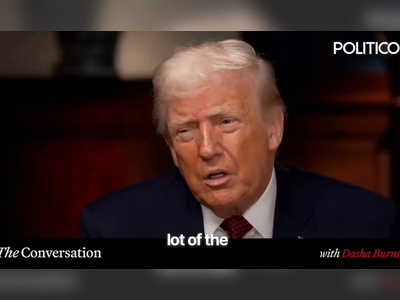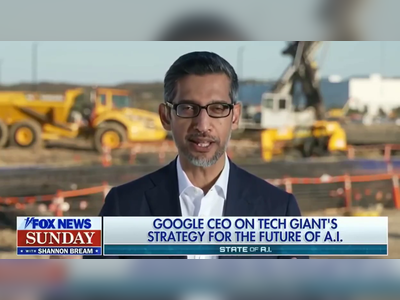
Why British Kids Went Back to School, and American Kids Did Not
Dragging pandemic policy into the culture war has been a disaster for the U.S., particularly its children.
The day I visited St. Thomas the Apostle School in Peckham, South London, a new shutdown was announced for Britain’s capital. But the comprehensive—a public high-school, in American parlance—was open. It was freezing: Doors were propped open for ventilation. Pupils chattered in the playground while wearing face coverings emblazoned with the school logo.
For all that, the experience felt surprisingly normal. In-person attendance has been at more than 90 percent for most of the term. Out front, some boys were playing a very serious game of soccer. Others messed around with basketballs.
St. Thomas is the sort of school that, in the United States, has largely offered hybrid or remote teaching. A study by the Center on Reinventing Public Education estimated that only 8 percent of U.S. urban school districts had returned to full in-person instruction in November. Outside the inner cities, only 22 percent of U.S. suburban school districts were running in-person schooling, and only 64 percent of rural districts.
Across the U.K., by contrast, schools—having closed in March—started reopening in June. After the summer break, all children could go back. The U.K. has struggled with the pandemic: COVID-19 has killed 73,000 people so far, a greater loss relative to the country’s population than in the U.S. Ministers made repeated missteps, including subsidizing eat-in restaurant meals over the summer.
But the average teenager in England has missed only about 6 days of in-person school during the fall. And in this regard, Britain is deeply European. Since September, according to the Blavatnik School of Government policy tracker, seven U.S. states have closed schools for a long spell while not forcing the closure of other workplaces. No European state has done so. School closures have remained the last resort.
Why, then, this transatlantic divide? The answer is a matter of centralization, consensus, and the role of teaching unions.
The decision to open St. Thomas and, indeed, all schools in England, was made by England’s education secretary, Gavin Williamson. Equivalent decisions were made by his counterparts in the Welsh, Scottish, and Northern Irish governments.
The teaching unions were unhappy about these calls. In May, Mary Bousted, one of the general secretaries of the National Education Union, the largest of the unions, said the first reopening plans were “nothing short of reckless.” The NEU’s preconditions for reopening—low caseloads and regular testing, in particular—were not met.
Bousted told me, “We have this education policy being run by hard-liners in [the prime minister’s office]. Schools are being kept open at all costs because of an economic imperative—because parents can’t work if the children aren’t in school.”
The unions were simply unable to leverage their large memberships for political effect. They are weak, and barely feature in England’s three-decade-long story of radical school reform. Opposition to reopening was also a particularly difficult stance to maintain.
In August, Chris Whitty, England’s chief medical officer, announced that “the chances of children dying from COVID-19 are incredibly small,” whereas school closure “damages children in the long run.” By the summer, this way of thinking had hardened into a consensus: The opposition Labour Party supported reopening.
No surprise, then, that teachers ultimately fell into line. In late August, TeacherTapp, a teacher pollster, found that 71 percent of teachers said they were looking forward to going back, a higher percentage than in previous summers.
Serge Cefai, the executive head teacher at St. Thomas, looked puzzled when I asked whether the unions had given him trouble. Not at all. “We told [staff] we’re going to follow guidelines and we do … We’ve spent a huge amount of money trying to make sure that staff feel safe when they come into school.”
Similar dynamics were apparent across Europe, and the strength of expert consensus dominated even in states with stronger unions and more decentralized government than the U.K. Ilka Hoffmann, a board member of the leading German education union, said: “The ministers in some states didn’t even talk with the school leaders.”
In the U.S., Secretary of Education Betsy DeVos pushed for schools to reopen. She said in July, “The rule should be that kids go back to school this fall.” But, unlike her peers in Europe, she could not make that rule. Washington contributes just 8 percent of U.S. schools’ budget. Such decisions fell to states, cities, and the country’s 13,600 school districts.
To outsiders, this fracturing has always been the American school system’s core oddity. It is why the U.S., unusually for a rich country, spends more on teaching its rich children than its poor. Success in the pandemic would have required federal leadership to set standards for safe reopening—standards that the various stakeholders found trustworthy. This did not arrive.
On the contrary, Laura Hallas, a researcher at the Blavatnik School, said that “the CDC, the White House, and governors’ offices sometimes presented divergent messaging around when and how schools should open for fall.” Some states stepped forward to take a lead. Many, however, left the districts to decide among themselves.
Against the backdrop of a fierce election, advice was politicized. Parents’ and teachers’ views on reopening became partisan. A paper published by Brown University found that school boards in areas that voted for Donald Trump were more likely to heed the education secretary’s call to keep schools open. Politics mattered more than local disease levels in determining local responses.
Another factor identified by the paper was the strength of teaching unions—a far more powerful force in the U.S. than across Europe. The National Education Association and the American Federation of Teachers, the largest teaching unions in the U.S., spent a combined $24 million in the 2020 electoral cycle.
They were able to threaten local strikes against individual school boards—local decision makers whom they know and negotiate with all the time—rather than try to run full-blown national campaigns to apply pressure to national leaders, which was what the European unions faced.
Katharine Strunk, an education-policy professor at Michigan State University, said unions were willing to “support their teachers in strike authorization if teachers felt that they were being forced back into unsafe conditions. That sometimes meant proper social distancing, but it sometimes meant a universally available vaccine.”
Unions were able to influence decision making in part because, as Strunk said, “when there is no good trusted advice, it’s hard for parents or school boards to argue against [the unions], because what [the unions were] saying was: ‘Isn’t one teacher or one student death too much of a cost when they can learn fine remotely?’”
Lacking a trusted federal lead created space for the unions’ caution. Randi Weingarten, the president of the American Federation of Teachers, told me that “parents spoke with their feet in terms of … saying, ‘I'm not going back to schools like that.’ Educators said, ‘I can’t teach like that.’ And administrators were not able to put the resources together … Nobody trusted the CDC, unfortunately, because they kept on changing their mind … And nobody trusted DeVos or Trump when it came to kids.”
In New York City, the United Federation of Teachers used the threat of a strike to delay the return to in-person teaching. Schools partially reopened in late September under a hybrid model that emerged from a tense negotiation between government officials and the UFT. By November, schools were shut again when the citywide prevalence of the coronavirus breached an agreed-upon threshold—–more than 3 percent of COVID-19 tests were coming back positive.
Although elementary schools in the city were reopened quickly and Mayor Bill de Blasio vowed not to close them again, this reversal could not have happened without a new acceptance in the union movement that elementary schools are relatively safe to open.
Weingarten said teachers have learned since the summer that elementary schools are by and large low risk—-not least from the experience of New York City’s reopening. “We used to think that it was going to be harder for young kids” to comply with safety protocols, she said, “but young kids have taken to the safeguards and are willing to do them.”
Evidence is mounting that school closures have been bad for children. A McKinsey study of K–5 students from the U.S. found that even students who managed to get back into the classroom by mid-October had lost the equivalent of three months of math learning and one and a half months of reading.
The final figures are likely to be much higher when the hybrid- and remote-learning students are finally assessed: A similar study in the U.K. using test data from October found that a sample of 11-year-olds had lost 22 months’ worth of progress in writing ability during Britain’s relatively brief period of online learning.
This learning penalty will not be even. Higher learning loss will occur among poorer children, who are less likely to have the computers, space, quiet, and good internet connections required to make remote learning work. In the U.S., pupils of color will suffer particularly: They are more likely to be poor, and the schools they attend are less likely to offer the option of in-person instruction.
The U.S. education system would have struggled with this pandemic no matter what. Its kaleidoscopic fragmentation and the strength of its teachers’ unions would have presented a formidable challenge to smooth school reopenings in any circumstance.
But the politicization of pandemic advice, for which the Trump administration must take a large share of the blame, made these structural realities into near-insurmountable impediments. Dragging pandemic policy into the culture war has been a disaster for the country, particularly its children.
The American death toll will rightly be cited as the main indictment of the U.S. government’s handling of the pandemic. But what has happened in schools is an astonishing public-policy failure of its own.
For all that, the experience felt surprisingly normal. In-person attendance has been at more than 90 percent for most of the term. Out front, some boys were playing a very serious game of soccer. Others messed around with basketballs.
St. Thomas is the sort of school that, in the United States, has largely offered hybrid or remote teaching. A study by the Center on Reinventing Public Education estimated that only 8 percent of U.S. urban school districts had returned to full in-person instruction in November. Outside the inner cities, only 22 percent of U.S. suburban school districts were running in-person schooling, and only 64 percent of rural districts.
Across the U.K., by contrast, schools—having closed in March—started reopening in June. After the summer break, all children could go back. The U.K. has struggled with the pandemic: COVID-19 has killed 73,000 people so far, a greater loss relative to the country’s population than in the U.S. Ministers made repeated missteps, including subsidizing eat-in restaurant meals over the summer.
But the average teenager in England has missed only about 6 days of in-person school during the fall. And in this regard, Britain is deeply European. Since September, according to the Blavatnik School of Government policy tracker, seven U.S. states have closed schools for a long spell while not forcing the closure of other workplaces. No European state has done so. School closures have remained the last resort.
Why, then, this transatlantic divide? The answer is a matter of centralization, consensus, and the role of teaching unions.
The decision to open St. Thomas and, indeed, all schools in England, was made by England’s education secretary, Gavin Williamson. Equivalent decisions were made by his counterparts in the Welsh, Scottish, and Northern Irish governments.
The teaching unions were unhappy about these calls. In May, Mary Bousted, one of the general secretaries of the National Education Union, the largest of the unions, said the first reopening plans were “nothing short of reckless.” The NEU’s preconditions for reopening—low caseloads and regular testing, in particular—were not met.
Bousted told me, “We have this education policy being run by hard-liners in [the prime minister’s office]. Schools are being kept open at all costs because of an economic imperative—because parents can’t work if the children aren’t in school.”
The unions were simply unable to leverage their large memberships for political effect. They are weak, and barely feature in England’s three-decade-long story of radical school reform. Opposition to reopening was also a particularly difficult stance to maintain.
In August, Chris Whitty, England’s chief medical officer, announced that “the chances of children dying from COVID-19 are incredibly small,” whereas school closure “damages children in the long run.” By the summer, this way of thinking had hardened into a consensus: The opposition Labour Party supported reopening.
No surprise, then, that teachers ultimately fell into line. In late August, TeacherTapp, a teacher pollster, found that 71 percent of teachers said they were looking forward to going back, a higher percentage than in previous summers.
Serge Cefai, the executive head teacher at St. Thomas, looked puzzled when I asked whether the unions had given him trouble. Not at all. “We told [staff] we’re going to follow guidelines and we do … We’ve spent a huge amount of money trying to make sure that staff feel safe when they come into school.”
Similar dynamics were apparent across Europe, and the strength of expert consensus dominated even in states with stronger unions and more decentralized government than the U.K. Ilka Hoffmann, a board member of the leading German education union, said: “The ministers in some states didn’t even talk with the school leaders.”
In the U.S., Secretary of Education Betsy DeVos pushed for schools to reopen. She said in July, “The rule should be that kids go back to school this fall.” But, unlike her peers in Europe, she could not make that rule. Washington contributes just 8 percent of U.S. schools’ budget. Such decisions fell to states, cities, and the country’s 13,600 school districts.
To outsiders, this fracturing has always been the American school system’s core oddity. It is why the U.S., unusually for a rich country, spends more on teaching its rich children than its poor. Success in the pandemic would have required federal leadership to set standards for safe reopening—standards that the various stakeholders found trustworthy. This did not arrive.
On the contrary, Laura Hallas, a researcher at the Blavatnik School, said that “the CDC, the White House, and governors’ offices sometimes presented divergent messaging around when and how schools should open for fall.” Some states stepped forward to take a lead. Many, however, left the districts to decide among themselves.
Against the backdrop of a fierce election, advice was politicized. Parents’ and teachers’ views on reopening became partisan. A paper published by Brown University found that school boards in areas that voted for Donald Trump were more likely to heed the education secretary’s call to keep schools open. Politics mattered more than local disease levels in determining local responses.
Another factor identified by the paper was the strength of teaching unions—a far more powerful force in the U.S. than across Europe. The National Education Association and the American Federation of Teachers, the largest teaching unions in the U.S., spent a combined $24 million in the 2020 electoral cycle.
They were able to threaten local strikes against individual school boards—local decision makers whom they know and negotiate with all the time—rather than try to run full-blown national campaigns to apply pressure to national leaders, which was what the European unions faced.
Katharine Strunk, an education-policy professor at Michigan State University, said unions were willing to “support their teachers in strike authorization if teachers felt that they were being forced back into unsafe conditions. That sometimes meant proper social distancing, but it sometimes meant a universally available vaccine.”
Unions were able to influence decision making in part because, as Strunk said, “when there is no good trusted advice, it’s hard for parents or school boards to argue against [the unions], because what [the unions were] saying was: ‘Isn’t one teacher or one student death too much of a cost when they can learn fine remotely?’”
Lacking a trusted federal lead created space for the unions’ caution. Randi Weingarten, the president of the American Federation of Teachers, told me that “parents spoke with their feet in terms of … saying, ‘I'm not going back to schools like that.’ Educators said, ‘I can’t teach like that.’ And administrators were not able to put the resources together … Nobody trusted the CDC, unfortunately, because they kept on changing their mind … And nobody trusted DeVos or Trump when it came to kids.”
In New York City, the United Federation of Teachers used the threat of a strike to delay the return to in-person teaching. Schools partially reopened in late September under a hybrid model that emerged from a tense negotiation between government officials and the UFT. By November, schools were shut again when the citywide prevalence of the coronavirus breached an agreed-upon threshold—–more than 3 percent of COVID-19 tests were coming back positive.
Although elementary schools in the city were reopened quickly and Mayor Bill de Blasio vowed not to close them again, this reversal could not have happened without a new acceptance in the union movement that elementary schools are relatively safe to open.
Weingarten said teachers have learned since the summer that elementary schools are by and large low risk—-not least from the experience of New York City’s reopening. “We used to think that it was going to be harder for young kids” to comply with safety protocols, she said, “but young kids have taken to the safeguards and are willing to do them.”
Evidence is mounting that school closures have been bad for children. A McKinsey study of K–5 students from the U.S. found that even students who managed to get back into the classroom by mid-October had lost the equivalent of three months of math learning and one and a half months of reading.
The final figures are likely to be much higher when the hybrid- and remote-learning students are finally assessed: A similar study in the U.K. using test data from October found that a sample of 11-year-olds had lost 22 months’ worth of progress in writing ability during Britain’s relatively brief period of online learning.
This learning penalty will not be even. Higher learning loss will occur among poorer children, who are less likely to have the computers, space, quiet, and good internet connections required to make remote learning work. In the U.S., pupils of color will suffer particularly: They are more likely to be poor, and the schools they attend are less likely to offer the option of in-person instruction.
The U.S. education system would have struggled with this pandemic no matter what. Its kaleidoscopic fragmentation and the strength of its teachers’ unions would have presented a formidable challenge to smooth school reopenings in any circumstance.
But the politicization of pandemic advice, for which the Trump administration must take a large share of the blame, made these structural realities into near-insurmountable impediments. Dragging pandemic policy into the culture war has been a disaster for the country, particularly its children.
The American death toll will rightly be cited as the main indictment of the U.S. government’s handling of the pandemic. But what has happened in schools is an astonishing public-policy failure of its own.
AI Disclaimer: An advanced artificial intelligence (AI) system generated the content of this page on its own. This innovative technology conducts extensive research from a variety of reliable sources, performs rigorous fact-checking and verification, cleans up and balances biased or manipulated content, and presents a minimal factual summary that is just enough yet essential for you to function as an informed and educated citizen. Please keep in mind, however, that this system is an evolving technology, and as a result, the article may contain accidental inaccuracies or errors. We urge you to help us improve our site by reporting any inaccuracies you find using the "Contact Us" link at the bottom of this page. Your helpful feedback helps us improve our system and deliver more precise content. When you find an article of interest here, please look for the full and extensive coverage of this topic in traditional news sources, as they are written by professional journalists that we try to support, not replace. We appreciate your understanding and assistance.
